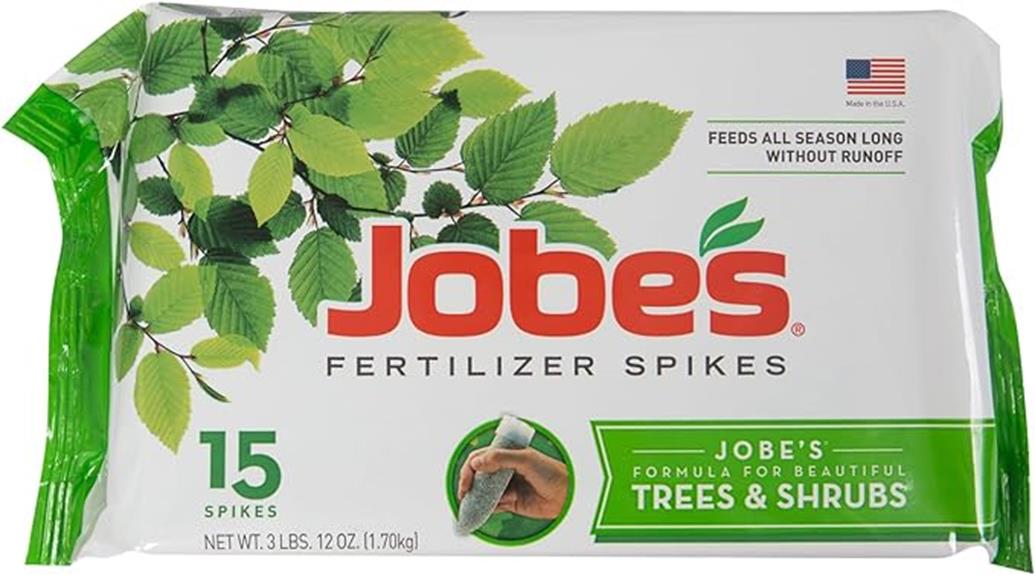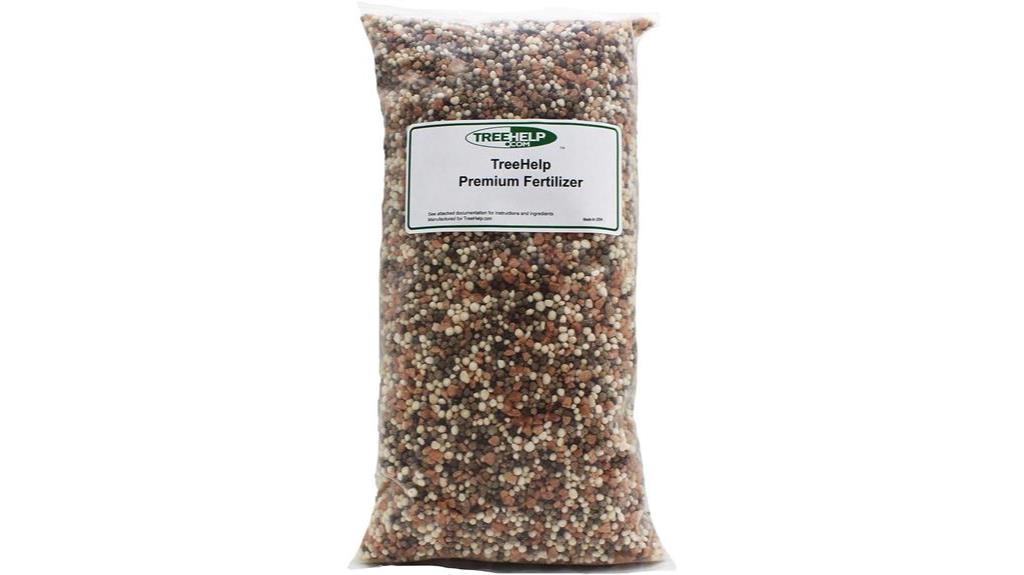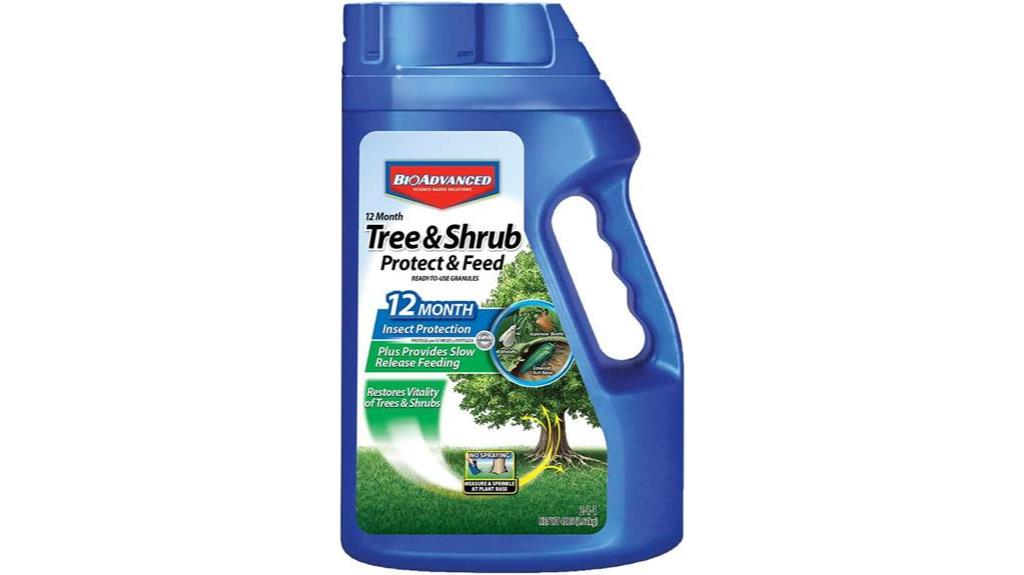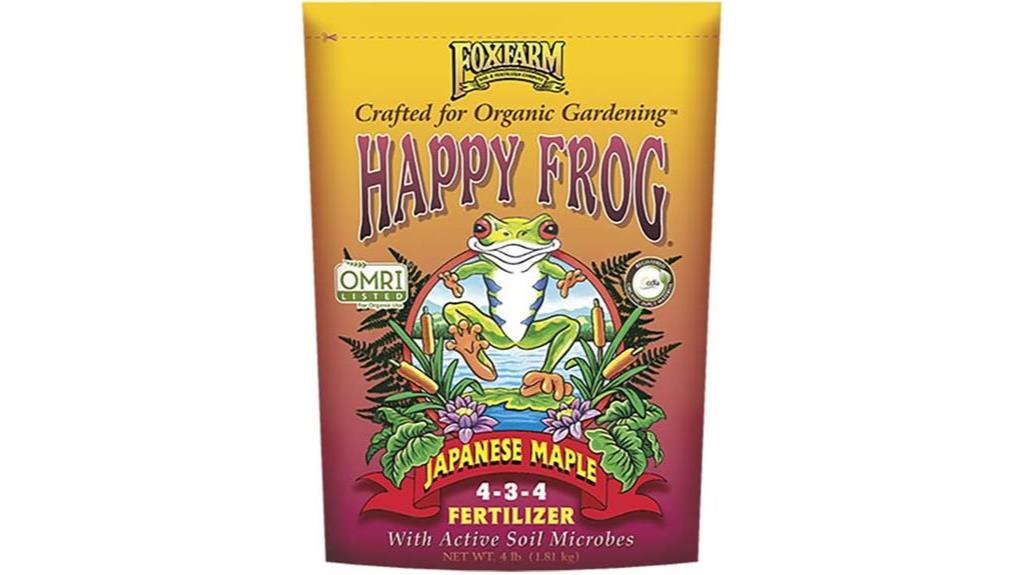Imagine your maple trees standing tall and vibrant, their leaves shimmering in the sunlight like emerald jewels. To achieve this lush appearance, you'll need to take into account the right fertilizers that cater to their specific needs. With so many options available, it's essential to know which products can truly nourish your trees and promote healthy growth. Let's explore five top fertilizers that not only support your maples but also enhance their natural beauty, ensuring they thrive year after year.
Jobe's Slow Release Tree and Shrub Fertilizer Spikes (15 Count)

If you're looking for a hassle-free way to nourish your maple trees, Jobe's Slow Release Tree and Shrub Fertilizer Spikes are an excellent choice. With a convenient 15-count pack, these spikes deliver a balanced NPK ratio of 16-4-4, guaranteeing your trees receive essential nutrients twice a year—just in early spring and late fall. I love how easy they are to use; just water the soil, insert the spikes around the tree's drip line, and forget about it! The slow-release formula guarantees a steady nutrient supply without the risk of over-fertilizing. Plus, there's no mess or strong odors. With a solid rating of 4.6 stars from thousands of users, I can confidently say these spikes are effective for maintaining healthy maple trees.
Best For: Home gardeners looking for an easy and effective way to nourish acid-loving trees and shrubs like maple, oak, and dogwood.
Pros:
- Convenient: Pre-measured spikes simplify application with no mixing or measuring needed.
- Slow Release: Provides continuous nutrients to active roots, promoting healthy growth.
- Environmental Friendly: Designed to minimize wasteful runoff and unpleasant odors.
Cons:
- Soil Condition: Difficulties may arise when inserting spikes into hard or compacted soil.
- Specific Tree Issues: Some users reported limited effectiveness with certain tree types, such as oak.
- Frequency of Use: Requires application twice a year, which may be less convenient for some gardeners.
Fox Farm Happy Frog® Japanese Maple Fertilizer, 4 lb Bag

Fox Farm Happy Frog® Japanese Maple Fertilizer is the ideal choice for anyone looking to nurture their Japanese maples and other low pH feeders. This 4 lb fertilizer is packed with essential nutrients, including phosphorus and potassium, that support tree health. I love how it's specifically formulated for Japanese maples, but it also works great for other plants like hydrangeas and evergreens.
What sets it apart is the inclusion of mycorrhizal fungi, which boosts root efficiency, enhancing nutrient uptake and water absorption. It's OMRI Listed, making it suitable for organic gardening. With a stellar rating of 4.6 out of 5 stars from over 500 customers, it's clear that this fertilizer delivers impressive results for thriving trees.
Best For: Gardeners looking to promote the health and growth of Japanese maples and other low pH feeder plants.
Pros:
- Effective formulation specifically designed for Japanese maples and similar plants.
- Contains mycorrhizal fungi to enhance root efficiency and nutrient uptake.
- OMRI Listed, making it suitable for organic gardening practices.
Cons:
- Limited to specific plant types; may not be suitable for all garden plants.
- Available only in a 4 lb bag, which may not be enough for larger gardens.
- Some users may find the powder form less convenient compared to granular options.
Premium Fertilizer for Maple

For anyone looking to enhance the health and vigor of their maple trees, TreeHelp Premium Fertilizer is an excellent choice. This 3-pound granule formula is specially designed for maple trees, promoting robust root development and long-term well-being. I appreciate the slow-release nitrogen, which provides continuous feeding throughout the growing season. It's great knowing that it also supplies essential nutrients to help trees fight infections.
What impresses me most is the positive feedback from users, averaging 4.5 out of 5 stars. Many report noticeable improvements in tree health and appearance after using it. With clear application instructions included, it's simple to use during the growing season. Overall, TreeHelp Premium Fertilizer is a fantastic investment for any maple tree enthusiast.
Best For: TreeHelp Premium Fertilizer is best for homeowners and gardeners looking to improve the health and growth of their maple trees.
Pros:
- Effective slow-release nitrogen formula ensures continuous feeding throughout the growing season.
- Positive customer feedback highlights significant improvements in tree health and appearance.
- Easy-to-follow application instructions make it user-friendly for all skill levels.
Cons:
- Coverage is limited to one large tree or 2-3 smaller/newly planted trees, which may not be sufficient for larger properties.
- The product may take time to show noticeable results, requiring patience from users.
- Limited availability in some regions could make purchasing more challenging.
BioAdvanced 12 Month Tree and Shrub Protect and Feed, Granules, 4 lb

Looking to simplify your garden care while effectively protecting your maple trees? I highly recommend BioAdvanced 12 Month Tree and Shrub Protect and Feed. This 4 lb granule product not only nourishes your trees with its 2-1-1 NPK analysis but also offers 12-month protection against pests like Japanese beetles and aphids. It's easy to apply—just scatter the granules at the base of your trees. Once absorbed, it provides systemic protection from roots to leaves, ensuring your trees stay healthy throughout the seasons. Plus, it's rainproof after absorption, making it hassle-free. Just remember, it's not suitable for edible plants, so use it wisely. With a single application, you can enjoy thriving maple trees all year round!
Best For: Homeowners looking to protect and nourish their non-edible trees and shrubs from pests while simplifying their garden care routine.
Pros:
- Easy application—just shake and scatter.
- Treats a wide variety of pests.
- Long-lasting—only needs to be applied once a year.
Cons:
- Toxic to edible plants; must be used with caution.
- Risk of contamination if applied improperly.
- Price increases noted by some customers over the years.
Happy Frog® Japanese Maple Organic Plant Fertilizer

If you're nurturing Japanese maples, then Happy Frog® Japanese Maple Organic Plant Fertilizer is an excellent choice. This product from FoxFarm comes in a convenient 4-pound package, making it easy to handle and store. With a stellar rating of 4.7 out of 5 stars from 535 reviews, it's clear that many users appreciate its effectiveness. I love how simple it is to apply—just sprinkle the recommended amount and work it into the soil monthly. It's designed specifically for mature maples, delivering essential nutrients without burning the leaves. I've noticed improved foliage color and growth in my trees, and some users even report rapid results like leaf bud emergence within days. Overall, Happy Frog is a great investment for your maples!
Best For: Those looking to nourish and enhance the growth of Japanese maples while ensuring optimal leaf health.
Pros:
- Easy application with simple monthly instructions.
- Improves foliage color and promotes healthy growth.
- Specifically formulated to provide nutrients without burning leaves.
Cons:
- Some customers have reported receiving expired products.
- Limited to use on Japanese maples, may not suit other plants.
- Requires consistent application for best results.
Factors to Consider When Choosing Maple Tree Fertilizers
When choosing fertilizers for your maple trees, it's crucial to take into account their specific nutrient needs and the soil pH. You should also think about the different release formulations available and how often you'll need to apply the product. Finally, keep in mind the environmental impact of fertilizers to guarantee you're making a responsible choice.
Nutrient Requirements of Maples
Understanding the nutrient requirements of maple trees is fundamental for their healthy growth and development. To thrive, these trees typically need a balanced supply of nitrogen, phosphorus, and potassium (NPK) with an ideal ratio of about 3-1-1. Nitrogen plays a significant role in promoting vigorous leaf growth and overall vitality, so you'll want to guarantee your maple gets enough of it. Phosphorus is essential for strong root development and flowering, while potassium enhances disease resistance, particularly during stressful conditions.
Additionally, don't overlook the importance of micronutrients like iron, magnesium, and manganese. These elements are key for preventing deficiencies that can lead to chlorosis and hinder your tree's growth. When selecting a fertilizer, it's important to take into account these nutrient requirements to support your maple's specific needs.
Keep in mind that the soil pH can also influence nutrient availability, so while we won't explore that just yet, confirm your soil is slightly acidic, ideally within the 6.0 to 6.5 range. By focusing on the right nutrients, you'll help your maple trees flourish, leading to a vibrant and healthy landscape.
Soil Ph Considerations
Soil pH plays a vital role in the overall health of your maple trees and directly impacts nutrient availability. Maple trees thrive in slightly acidic to neutral soil, ideally between a pH of 6.0 to 7.0. When soil pH drops below 6.0, essential nutrients like phosphorus become less available, potentially stunting your tree's growth.
To guarantee your maples get the nutrients they need, regular soil testing is essential. Monitoring pH levels helps you maintain the ideal range and avoid nutrient deficiencies caused by imbalances. If you discover that your soil is too acidic, consider using organic fertilizers, which can help lower pH levels and benefit your acid-loving maples. On the other hand, synthetic fertilizers may not greatly alter pH, so choose wisely based on your soil's needs.
Release Formulations Available
Choosing the right fertilizer for your maple trees involves considering the different release formulations available. You'll find options like slow-release spikes, granules, and powders, each offering unique nutrient delivery methods to suit your needs.
Slow-release fertilizers are a solid choice if you want a consistent supply of nutrients over time. They help reduce the risk of over-fertilization, so you won't have to apply them as frequently. Granular fertilizers are also popular because they're easy to apply and can be mixed into the soil, helping enhance root uptake of nutrients.
If you're looking for quick nutrient availability, powdered fertilizers may be the way to go. However, be cautious with your measurements to avoid burning your trees' roots or foliage. Additionally, consider organic fertilizers, which often contain beneficial microorganisms that improve soil health and nutrient absorption. This can be especially advantageous for sensitive species like maples.
Application Frequency and Timing
When it comes to applying fertilizer to your maple trees, timing and frequency are essential for achieving ideal growth. Most fertilizers recommend applying them twice a year—once in early spring and again in late fall. This schedule supports your trees during their active growing season. However, if you opt for slow-release fertilizers, you can benefit from continuous nutrient supply over an extended period, which means less frequent applications.
It's important to water the soil thoroughly before applying any fertilizer. This step helps guarantee proper nutrient absorption and prevents root burn. Additionally, be mindful of the timing; applying fertilizers too late in the fall can stimulate growth that might not survive winter conditions.
Monitoring the specific needs of your maple tree species is key. Some trees might require more frequent feeding based on their growth rate and overall health. By paying attention to these factors, you can tailor your fertilization schedule, making sure your maple trees thrive and remain healthy throughout the seasons.
Environmental Impact of Fertilizers
Fertilizers can greatly impact the environment, making it essential to contemplate their effects before applying them to your maple trees. When used excessively or incorrectly, fertilizers can contribute to nutrient runoff, which leads to water pollution and harmful algal blooms in nearby aquatic ecosystems. To mitigate this risk, consider using slow-release fertilizers. These are designed to minimize leaching and runoff by gradually releasing nutrients over time, providing a more sustainable option for your trees.
You might also want to explore organic fertilizers, as they often come with a lower environmental impact. These fertilizers enhance soil health and biodiversity without introducing synthetic chemicals. Timing matters, too; applying fertilizers during rainy seasons can increase the likelihood of runoff and contamination of water bodies.
Target Tree Species
Understanding the specific needs of your maple tree species is key to selecting the right fertilizer. Different species have varying nutrient requirements, so it's crucial to know which type of maple you're nurturing. For instance, Japanese maples thrive with fertilizers that have lower pH levels, as they prefer more acidic conditions for ideal nutrient uptake.
When choosing fertilizers, look for those specifically designed for maple trees. These often feature a balanced NPK ratio and include additional micronutrients to support healthy growth and root development. Application frequency is also important; some maple species need seasonal feeding, while others do better with slow-release options that provide nutrients over time.
Consider the growth stage of your tree, too. Young maples may require different nutrients compared to mature ones, and understanding their environmental conditions will help you make the best choice. By aligning your fertilizer selection with your specific maple species, you'll guarantee your trees receive the nutrients they need to thrive and flourish. Remember, a little research can go a long way in promoting the health of your maple trees!
Organic vs. Synthetic Options
Choosing between organic and synthetic fertilizers for your maple trees can greatly impact their growth and health. Organic fertilizers, like those containing mycorrhizal fungi, enhance root efficiency and improve nutrient uptake. This can be particularly beneficial for maple trees, which thrive in low pH conditions. On the other hand, synthetic fertilizers offer more immediate nutrient availability, often leading to faster plant responses. However, they carry the risk of over-fertilization if not applied carefully.
When deciding, consider your maple tree's specific nutrient needs and your preferences regarding environmental impact. Organic options generally have a lower risk of nutrient runoff and are more sustainable for long-term use. They also improve soil structure and microbial activity over time, enhancing overall plant health and resilience. In contrast, many synthetic fertilizers provide short-term benefits, which might not support long-lasting growth.
Ultimately, balancing both types can be effective. Use organic fertilizers for ongoing soil health and resilience while applying synthetic options for quick nutrient boosts when necessary. This approach allows you to enjoy the benefits of both worlds, ensuring your maple trees thrive.
Frequently Asked Questions
How Often Should I Fertilize My Maple Trees?
You should fertilize your maple trees once in early spring and again in late summer. This timing helps support healthy growth and prepares them for the upcoming seasons. If you notice any signs of nutrient deficiency, like yellowing leaves, you might want to adjust your schedule. Always follow the recommended application rates for the fertilizer you choose, and remember that over-fertilizing can harm your trees, so moderation is key.
Can I Use General-Purpose Fertilizer for Maple Trees?
If you're looking to keep your maple trees in tip-top shape, you can use general-purpose fertilizer, but it's not always the best choice. While it'll provide some nutrients, specialized fertilizers are tailored for maple trees' unique needs. Think of it as trying to fit a square peg in a round hole. So, if you want your trees to thrive, consider opting for a fertilizer specifically formulated for them instead.
What Signs Indicate My Maple Tree Needs Fertilization?
If your maple tree's leaves are small, discolored, or dropping prematurely, it's a sign it might need fertilization. You should also watch for stunted growth or weak branch development. If your tree shows poor overall health or struggles to produce vibrant foliage in spring, it's time to contemplate feeding it. Regularly checking your tree's appearance will help you catch these signs early, ensuring your maple remains healthy and thriving.
Are There Organic Options for Fertilizing Maple Trees?
You won't believe how much your maple tree will thrive with organic fertilizers! Yes, there are fantastic options out there. You can use compost, which enriches the soil and promotes healthy growth. Bone meal is another great choice, packed with phosphorus for robust root development. Don't forget about fish emulsion; it's like a superfood for your tree! With these organic solutions, you'll see your maple tree flourish like never before!
How Do I Apply Fertilizer to My Maple Trees?
To apply fertilizer to your maple trees, start by choosing a suitable fertilizer based on soil tests and tree needs. Spread the granules evenly around the tree's drip line, avoiding direct contact with the trunk. Water the area well after applying to help the nutrients penetrate the soil. If you're using liquid fertilizer, mix it according to instructions and apply directly to the soil. Timing is key, so fertilize in early spring or fall for best results.
Wrapping Up
In nurturing your maple trees, choosing the right fertilizer is like picking the perfect partner for a dance; it sets the rhythm for growth and importance. By selecting from these top five options, you're ensuring your trees thrive with vibrant foliage and strong roots. Remember, a little care goes a long way in cultivating a flourishing landscape. So, give your maples the nutrients they need and watch them flourish like a masterpiece in nature's gallery.
